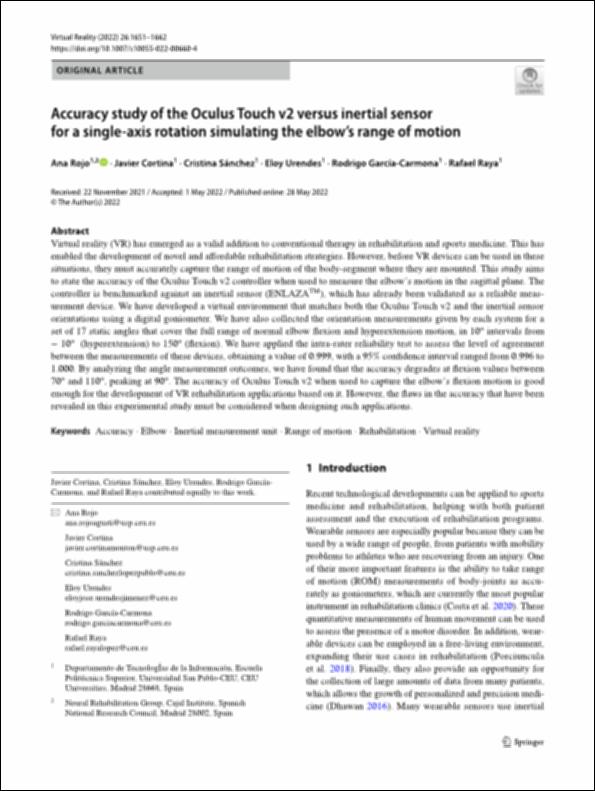Please use this identifier to cite or link to this item:
http://hdl.handle.net/10637/15038Accuracy study of the Oculus Touch v2 versus inertial sensor for a single-axis rotation simulating the elbow’s range of motion
| Title: | Accuracy study of the Oculus Touch v2 versus inertial sensor for a single-axis rotation simulating the elbow’s range of motion |
| Authors : | Rojo Agustí, Ana Cortina, Javier Sánchez López de Pablo, Cristina Urendes, Eloy García-Carmona, Rodrigo Raya López, Rafael |
| Keywords: | Accuracy; Elbow; Inertial measurement unit; Range of motion; Rehabilitation; Virtual reality |
| Publisher: | Springer |
| Citation: | Rojo, A., Cortina, J., Sánchez, C. et al. Accuracy study of the Oculus Touch v2 versus inertial sensor for a single-axis rotation simulating the elbow’s range of motion. Virtual Reality 26, 1651–1662 (2022). https://doi.org/10.1007/s10055-022-00660-4 |
| Abstract: | Virtual reality (VR) has emerged as a valid addition to conventional therapy in rehabilitation and sports medicine. This has enabled the development of novel and affordable rehabilitation strategies. However, before VR devices can be used in these situations, they must accurately capture the range of motion of the body-segment where they are mounted. This study aims to state the accuracy of the Oculus Touch v2 controller when used to measure the elbow’s motion in the sagittal plane. The controller is benchmarked against an inertial sensor (ENLAZA), which has already been validated as a reliable measurement device. We have developed a virtual environment that matches both the Oculus Touch v2 and the inertial sensor orientations using a digital goniometer. We have also collected the orientation measurements given by each system for a set of 17 static angles that cover the full range of normal elbow flexion and hyperextension motion, in 10° intervals from − 10° (hyperextension) to 150° (flexion). We have applied the intra-rater reliability test to assess the level of agreement between the measurements of these devices, obtaining a value of 0.999, with a 95% confidence interval ranged from 0.996 to 1.000. By analyzing the angle measurement outcomes, we have found that the accuracy degrades at flexion values between 70° and 110°, peaking at 90°. The accuracy of Oculus Touch v2 when used to capture the elbow’s flexion motion is good enough for the development of VR rehabilitation applications based on it. However, the flaws in the accuracy that have been revealed in this experimental study must be considered when designing such applications. |
| URI: | http://hdl.handle.net/10637/15038 |
| Rights : | http://creativecommons.org/licenses/by-nc-nd/4.0/deed.es |
| ISSN: | 1434-9957 |
| Issue Date: | 2022 |
| Center : | Universidad San Pablo-CEU |
| Appears in Collections: | Escuela de Politécnica Superior |
Items in DSpace are protected by copyright, with all rights reserved, unless otherwise indicated.


